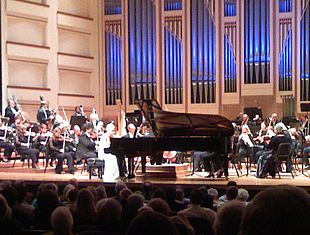| Works/Mp3 Description |
Genres
Piano concerto: Description |
| Buy cd's at Amazon Buy sheetmusic at SheetMusicPlus |
|
A piano concerto is a concerto written for piano and orchestra. See also harpsichord concerto; some of these works are occasionally played on piano. Joseph Haydn and Thomas Arne wrote concertos for fortepiano or harpsichord, at the period of time when they were in common usage (the late 18th century.)
HistoryClassical and RomanticAs the piano developed and became accepted, composers naturally started writing concerti for it. This happened in the late 18th century and so corresponded to the Classical music era. The most important composer in the development of the form in these early stages was Wolfgang Amadeus Mozart. Mozart's body of masterly piano concerti put his stamp firmly on the genre well into the Romantic era. Mozart wrote many of his 27 piano concertos for himself to perform (he also wrote concerti for two and three pianos). With the development of the piano virtuoso many composer-pianists did likewise, notably Ludwig van Beethoven, Carl Maria von Weber, Frédéric Chopin, Franz Liszt, Camille Saint-Saëns, Sergei Rachmaninoff and Sergei Prokofiev, and also the somewhat lesser-known Johann Nepomuk Hummel and John Field. Many other Romantic composers wrote pieces in the form, well known examples including the concerti by Robert Schumann, Edvard Grieg, Johannes Brahms, and Pyotr Ilyich Tchaikovsky. Edward Elgar made sketches for a piano concerto but never completed it. In the 19th century, Henry Charles Litolff blurred the boundary between a piano concerto and symphony in his five works entitled Concerto Symphonique, and Ferruccio Busoni added a male choir in the last movement of his hour-long concerto. The few well-known piano concerti which dominate today's concert programs and discographies account for only a minority of the repertoire which proliferated on the European music scene during the 19th century. 20th century and contemporaryThe piano concerto form survived through the 20th century into the 21st, with examples being written by Arnold Schoenberg, Béla Bartók, Igor Stravinsky, Sergei Prokofiev, Maurice Ravel, George Gershwin, Michael Tippett, Dmitri Shostakovich, Samuel Barber, Witold Lutosławski, György Ligeti, Elliott Carter, and others. Several 20th century examples also exist of concertos (or concertante works) written for two pianos and orchestra, such as those of Francis Poulenc (1932) and Bohuslav Martinů (1943). In parts of other 20th century symphonic works the piano is given occasional prominence like any other instrument of the orchestra, as in the Symphony in Three Movements by Igor Stravinsky and the Symphony No.3 by Michael Tippett. There are examples of piano concerti written to commissions by pianists. Paul Wittgenstein, who lost his right arm during World War I, on resuming his musical career asked a number of composers to write pieces for him which required the pianist to use his left hand only. The results of these commissions include concertante pieces for orchestra and piano left hand by Benjamin Britten, Franz Schmidt, Maurice Ravel, Paul Hindemith, Sergei Prokofiev (his Piano Concerto No. 4), Richard Strauss, and Erich Wolfgang Korngold. CharacteristicsFormA classical piano concerto is often in three movements.
Examples by Mozart and Beethoven follow this model, but there are many others which do not. Beethoven's fourth concerto includes a last-movement cadenza, and many composers have introduced innovations – for example Liszt's single-movement concerti. See alsoExternal links
References
| ||||||||||||||||
This article is licensed under the GNU Free Documentation License. It uses material from the Wikipedia article "Piano concerto". Allthough most Wikipedia articles provide accurate information accuracy can not be guaranteed. | ||||||||||||||||
Help us with donations or by making music available!
©2023 Classic Cat - the classical music directory

Wagner, R.
Das Liebesmahl der Apostel
US Marine Band
Beethoven, L. van
Piano Sonata No. 8 "Pathétique"
Tom Pascale
Chopin, F.
12 Etudes Op. 10
Sergio Calligaris
Rachmaninov, S.
10 Preludes
Alexander Djordjevic
Gershwin, G.
Rhapsodie in blue
Mauro Bertoli

